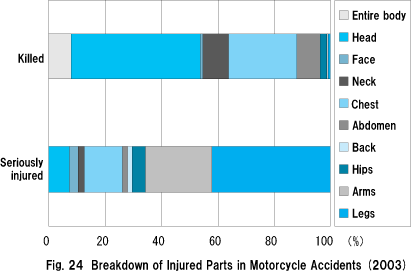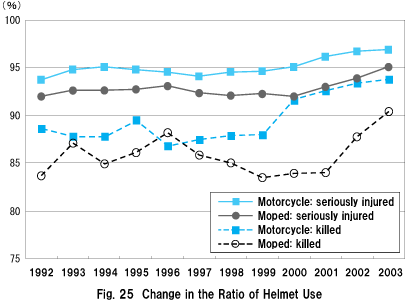In 2003, the number of traffic accident deaths fell from 8,326 in 2002 to 7,702. Of these, deaths of two-wheeled vehicle riders registered 1,353, a reduction of 144 deaths from the preceding year.
In this study, ITARDA has studied traffic accident statistics to examine the transition of two-wheeled
vehicle accidents, to analyze trends in 2003, and to find ways to prevent such accidents based on actual examples.
|
 Conclusion Conclusion |
- How to Avoid Motorcycle/Moped Accidents -
Based on the macro-statistical analysis and the case study above, precautions for both two-wheeled vehicle riders and car drivers are summarized in the following paragraphs.
1. Right-Turn/Straight-Ahead Collision
(1) Motorcycle/moped riders tend to assume that car drivers will recognize two-wheeled vehicles and wait
for them. Be aware that this is often not the case.
(2) Some car drivers try to make right turns first even after spotting an approaching motorcycle or moped.
Some even assume that the rider will slow down and wait for cars to go first.
(3) A survey shows that only 60% of two-wheeled vehicles keep the headlights on during the daytime. It is
preferable for riders to keep the headlights on during the daytime.
(4) Upon spotting a four-wheeled vehicle making a right turn, slow down and be ready to apply the brake
lever or foot brake. Avoid risks by taking other precautions as well, such as driving away from moving
cars wherever possible.
2. Crossing Collision
(1) Always stop for a safety check, whether or not there are approaching vehicles. Accidents occur at
places where riders and drivers assume "no vehicles will come". Simply assuming that it is usually safe
is a sure way to meet accidents.
(2) Often, both the driver and rider involved in an accident believed they had the right to go first. Being on
the priority road does not assure safety. Insisting on priority will not make accidents that have occurred
go away.
(3) A road mirror indicates that the place has poor visibility and serious accidents have occurred there.
Knowing that the place is an accident black spot, make sure to check the presence/absence of
approaching vehicles on a road mirror, and then check with your own eyes.
(4) Do not relax when a car stops. It could start at any time without spotting you.
3. Single-Vehicle Accident
(1) Rollover
a. Any sudden acceleration, braking and turning can cause a motorcycle/moped to roll over.
b. Roadsides, such as sandy strips, can be slippery. So are manhole covers and road joints, especially
when wet. Be extra careful on these spots when changing lanes and turning around.
(2) Crashes against guardrails, buildings, fences
a. Slow down when entering a curve.
b. Riders of large-displacement motorcycles must always be aware of how much one's vehicle veers
outside due to its weight and speed, especially when driving an unfamiliar vehicle.
(3) Crashing into parked vehicles
a. When riding two-wheeled vehicles (especially mopeds) at night, it is extremely important to secure
good forward vision. Take the trouble to toggle headlights up and down. When necessary, turn on high
beam to make sure there are no parked vehicles.
b. It is impossible to avoid a crash if there is a parked vehicle just around the curve when a rider is
speeding. It is extremely dangerous to accelerate when going into a curve.
4. Rear-end collision
(1) Due to the narrow width of two-wheeled vehicles, many riders believe that they can avoid rear-end
crashes by veering sideways even if the car in front brakes suddenly. But the faster the speed and the
heavier the vehicle, the greater the inertial force that makes the vehicle go straight forward.
Thus, rear-end crashes are sometimes unavoidable. Motorcycles/mopeds must also keep an appropriate
distance from the car in front.
5. Inspection and Maintenance of Two-Wheeled Vehicles
While not exactly the causes of accidents, there have been cases in which the outcome could have been
less serious if the motorcycle/moped had been kept in good condition by proper inspection and
maintenance.
(1) Some crashed vehicles had very low tire pressure, so much so that the tires yielded considerably when
pressed. With such tires, a vehicle cannot hold its upright position upon sudden braking. Always check
for soft tires when astride your vehicle.
(2) Some motor scooters had brake levers that easily touched the grips. Such brakes do not work when
sudden braking is needed.
Even an easy-to-drive and convenient motor scooter or moped requires proper inspection and
maintenance. Remember that your life depends on it.
6. Injured parts
Many riders who were killed in accidents had injuries to the head, chest and abdomen, whereas those
seriously injured were wounded in the arms and legs. When involved in an accident on a two-wheeled
vehicle with your body exposed, where you receive the injury makes the difference between life and death.
|
|
|

|
|
7. Wearing Helmets
In 2003, helmet usage among riders who were seriously injured in motorcycle/moped accidents was 97%
for motorcyclists and 95% of moped riders. The ratio of those wearing helmets was lower among those
who were killed: 90% for motorcyclists and 94% for moped riders. Some lives may have been saved if
victims had been wearing helmets. However, not just any helmet will do. Of the riders who were killed or
seriously injured, some were wearing helmets for construction works, helmets for fashion, and other types
of helmets that did not comply with safety standards. Others were not securing the helmet with the strap,
or were otherwise wearing the helmet improperly.
Also, there were cases in which riders were injured while wearing half helmets. Half helmets unbuckle
easily upon impact in a crash against a car or guardrail, thus allowing the exposed head to directly hit
objects. Even in a case where half helmets stayed in place, unprotected areas were often wounded. Some
fatal accidents made researchers wonder whether the helmets had been the full-face type. Helmets are
the only thing that offer protection to riders in an accident. Do not think you will never be involved in an
accident, and choose a helmet for safety, not for fashion or low price.
|
|
|

|
|
8. Riders' Mental State
During the case study, researchers interviewed accident victims to find out what mental state they were
in when they met the accident, and obtained the following answers. The responses were the same for car
drivers as well.
(1) I was not calm: irritated or hurried.
(2) I was temporarily off-guard, or somewhat distracted.
(3) I had worrisome troubles, or was thinking of something.
When on the road, riders must concentrate on driving alone. Since motorcycle/moped accidents cause
unexpectedly serious damage to the human body, "defensive driving" is extremely important, always
foreseeing what could happen next.
|
Institute for Traffic Accident Research and Data Analysis (ITARDA)
|
|




